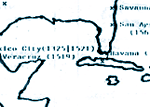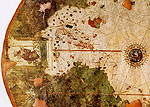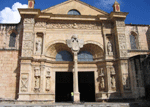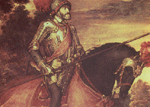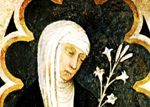Notes on
Latin American Renaissance Humanities Characteristics
1500 – 1600
I.
General
In
general Latin American culture
and humanities revolve predominantly around Spanish influence rather than
French, Portuguese, and indigenous influences. The reason for such a difference
corresponds directly to Spain
ascendancy during the first century of European discovery, conquest,
settlement, and colonization. Clearly, during the first century, indigenous
cultures were shocked into submission to the newcomers, and some pre-Columbian
peoples disappeared completely. This human disaster is particularly true in the
Caribbean. Although the French engaged in
voyages of discovery during the sixteenth century, their attempts at
colonization failed. The moderate French influence in Latin
America in the Renaissance period has to do mainly with their
constant attacks on coastal towns and the Spanish treasure fleets. Québec City
was not founded by the French until 1608. Meanwhile Portugal
founded the cities of São
Paulo and Rio de Janeiro in Brazil in
mid-century, but Portuguese Latin America did not develop significantly until
the next century. Spanish civilization during the sixteenth century, therefore,
is so prominent and dominant that it is called the Golden Age (el Siglo de Oro) both because of the
exploitation of precious metals—notably silver and gold—originating
in Latin America, but also because of the sophistication of Spanish arts and
letters. What is true about peninsular Spain
is also true in Spanish America.
Like all
other European and Asian countries that made a transition out of medieval
patterns characteriestic of the Middle Ages, Spain, France, and Portugal did so
too. Three of the major traits of medieval society are (1) hierarchical social
structures, (2) religion-centered lifestyles and beliefs, and (3)
non-individualistic pursuits. As these countries evolved into the Renaissance,
these three traits evolve too. First there is a growing split between secular and
religious powers, and the hegemony of the Roman Catholic Church is splintered
by the Protestant Reformation that began in 1517 in Germany. Second, as the
word "renaissance" itself suggests, there was a powerful rebirth of
classical, human-centered knowledge and productions in the arts and sciences.
In other words, knowledge began to be democratized, especially as the printing
press made access to knowledge open to a much larger segment of society. And
third, individuals began to assert their private right to seek and achieve
personal glory and fame in the here and now. Glory was no longer reserved for
the after life.
Some general tendencies one finds in Spanish
American humanities include the following: (1) The cities and towns that were
created near the coasts (architecture, urban planning) displayed very Iberian
(Spanish and Portuguese) features. Such cities include Santo Domingo, La Habana,
Veracruz, Pernambuco, Bahia, Concepción, and Lima. On the other hand, inland cities and towns
had more mestizo characteristics. (Mestizo refers to a mixture of European
and indigenous styles and peoples.) Exception to this general difference in
city styles are Puebla and Morelia
in México and Quito in Ecuador, all
three of which show predominantly Spanish—rather than
mestizo—styles in their historical cores (casco histórico). (2) As one would expect, significant art and
culture developed near major mining centers such as Zacatecas, Guanajuato, and Taxco in México, Potosí in Bolivia,
and Ouro Preto in Brazil.
(3) Furthermore, European influence in Latin America
during the first century the encounter showed strong signs of varying by
regions. For example, explorers, conquistadors, and colonists in México tended
to come from Extremadura and Castilla in Spain;
Cuba was influenced by
people from Galicia in
northwest Spain; Venezuela by immigrants from the Spanish Basque
region (el País Vasco); Brazil
by the Portuguese; and Québec by the French. For a hand-drawn map of some of Latin America's early European cities, see the following
map:
II. Early Renaissance Characteristics
As
you can see in the image link just above and another one near the bottom of
these notes about Latin American humanities in the Renaissance, the production
of maps is one of the most prominent concerns for explorers, conquistadors,
colonists, and sailors. It is also one of the most significant products of the
entire Colonial period. The most famous of these maps is the one produced by
Juan de la Cosa (1460-1510), who was a cartographer, conquistador, explorer,
and owner of one of Columbus's
three ships, the famous Santa María. He sailed with Columbus on the latter's first three voyages.
On Juan de la Cosa's own fourth voyage in 1499 (not with Columbus) he was accompanied by Amerigo
Vespucci. The entire continent of the Western Hemisphere came to be known by
Vespucci's first name (Amerigo -> America). On Juan de la
Cosa's fifth voyage (1500) he joined others in exploring
("discovering") Colombia
and the eastern coast of Panamá. In the same
year (1500) he produced the first map of the region of the so-called new New World that was most explored. The original of this
map is in the Naval Museum in Madrid,
Spain. For an
enlargement of this map see the poster (sold at the Naval Museum)
of it shown in class and/or click on the following image:
Spanish
history and humanities in the sixteenth century can be divided roughly along
the lines of the three monarchs that ruled throughout the century. First, the
Catholic Monarchs (los Reyes Católicos) ruled until 1516 (Queen Isabel I died
in 1504, her son Felipe el Hermoso died in 1506, and King Fernando V died in
1516). Carlos I (as king of Spain;
V as emperor of the Holy Roman Empire) ruled
from 1517 to 1556, and his son Felipe II ruled from 1556 to 1598. The period of
the Catholic Monarchs is dominated by the discovery and early conquests. The
predominant products of the humanities are letters, maps, and portolans
concerning the discoveries. The most characteristic style is known as plateresco, which is characteristic of
the fine work done by silver smiths. There is the slightest trace of this style
in the façades of the earliest churches built during the early Renaissance
period; however, the conquest was so new and so much energy was spent on other
activities such as war and survival that little remains of this style in Latin America. The oldest major building in Latin America
is the Catedral de Santo Domingo
(1516). This cathedral shows an exuberant mixture of styles, including
plateresque, Renaissance, and native elements. For a picture of Santo Domingo's cathedral,
click on the following image:
III.
The Reign of Carlos I (V) (1500 – 1558)
Carlos
I was the first king in the line of Hapsburg monarchs in Spain
(1517-1700). Almost as soon as he became king of Spain
he was elected emperor (1519) of the Holy Roman Empire
(Sacro Imperio Romano Germánico), he was crowned as Karl V (Carlos V / Charles
V).
The
period of Carlos V shows the following characteristics: freedom and syncretism
in church architecture and sculpture. In Spanish America the craftsmen and
artisans were mostly mestizos and indigenous people, whereas in Brazil they
were blacks and mulattoes (mixture of African and Portuguese peoples). Even
though the overall designs of buildings, sculptures, and art were Iberian,
since those who actually created the works were not Iberians, in Latin America we find that antithetical styles existed
simultaneously. Furthermore, practical and local needs (i.e., tropical heat,
earthquakes, hurricanes, etc.) meant that we see a pre-Columbian ornamental
structural sense. Walls are thicker than in Europe
and buildings have more ventilation. Even so, European ideas in the humanities
predominate: in the main they are aristocratic, noble, and oriented toward
pomp. (Later, in the sixteenth through the eighteenth centuries, the humanities
will be based more on the masses than one sees in Iberia. The humanities, therefore, in
the later colonial centuries, are more democratic than they are in Europe. This difference was due to the need to
proselytize the indigenous parishioners in the Catholic churches and missions.)
The first school of the arts in Latin America was set up in Quito, Ecuador,
in 1534, to foster religious instruction for the Ecuadorian Incas. The earliest
modifications in Iberian styles took place in México. These motifications
included the design and construction of fortress churches (see the Catedral de
Mérida); grandiose, syncretic Gothic architecture; small scale plateresque
church façades (see: => San Agustín Acolman),
capillas abiertas (open chapels,
which are courtyards for the large mass populations in México: see both Acolman and the Catedral de
Cuernavaca, for example), and very large monasteries begun
by Mexico's first viceroy (Antonio Hurtado de Mendoza, 1535 – 1550),
which was built around a cloister and was two stories high.
Mendoza
was the first viceroy of México and the third viceroy of Perú (1551 –
1552), where he died and was buried. He authorized the expeditions of Francisco
Vásquez de Coronado throughout what is now much of the Southwest of the United States of America (1540 – 1542),
Juan Rodríguez Cabrillo to the west coast of California (1542 – 1543), and Ruy
López Zumárraga to the Philippeans (1542 – 1543). As the great humanist
that he was, and of special interest concerning the encounter with native
humanities, he commissioned the creation of an Aztec codex, which is known as
the Codex Mendoza. In 1536 he joined forces with the bishop (Juan de Zumárraga)
in founding the Colegio de Santa Cruz at Tlatelolco (the famous Plaza de las
Tres Culturas in the Tlatelolco neighborhood in Mexico City), which was an
institution where sons of the remaining Aztec nobility studied Latin humanities
subjects such as Latin, philosophy, and music. He introduced the first printing
press in the New World in 1539, and he oversaw
the construction of hospitals, schools, ranches, and mines. Also, he began the
process for creating the first two universities in the New World: the
Universidad de San Marcos in Lima, Perú (1551) and the Royal and
Pontificial University of Mexico (1552), which became the Universidad Nacional
Autónoma de México (UNAM).
IV.
Renaissance During the reign of Felipe II (1556 – 1598)
It
is important to take into consideration that during the period of these three
monarchies (Catholic Monarchs, Carlos V, Felipe II), Spain expanded from
controlling only about half of the Iberian Peninsula to: (1) the entire Iberian
Peninsula; (2) islands in the Atlantic Ocean; (3) enclaves on the north coast
of Africa, (4) claims to almost all of the Western Hemisphere (except for what
Portugal on the tip of Brazil); (5) islands throughout the Pacific Ocean
including the Philippeans; (6) and immense Hapsburg territories throughout
Europe. Here is a rough map of just some of Spanish imperial control in western Europe alone:
Due
to the stern tastes and stern Catholic theology of King Felipe II, the
Renaissance was elegant, proportional, relatively simple or spare, and
doctrinally correct. Painting, for example, could only be imported from Europe. However, sculpture was freer due to the need to
use indigenous craftsmen and artisans. For example, one sees a profusion of
indigenous relief decoration with native animals, plants, and colors. Church
architecture shows friezes with Aztec virgins, local fruit, flowers, fauna, and
native physiognomies. The Catedral Metropolitana de México in Mexico City is a prime example of the Spanish
approach to the humanities during the second half of the sixteenth century.
Construction of this cathedral was begun in 1563, the same year as Felipe II
moved the Spanish capital to Madrid and
started construction of the Escorial, which is Spain's
rough equivalent of the Versailles palace in France. The
Catedral de México is characterized by majestic sweep and monumental
Renaissance architecture. It has a special foundation due to the swampy ground
where it stands (modern engineers reconstructed its foundations in order to
save it early in the twenty-first century). This monumental building, which was
built using the razed building blocks of the Aztec's Great Pyramid, has more
light than comparable Spanish churches. Furthermore, it was built over several
centuries. Hence, it has a baroque façade and a neoclassical eighteenth-century
dome.
Another
significant Latin American institution that illustrates the Renaissance traits
characteristics of the second half of the sixteenth century is the Convento de
Santa Catalina in Arequipa,
Perú. It is important to remember that Spaniards from all social classes, from
the king to the common devout citizen, took the defense of strict Catholicism
very seriously. Felipe II and Spanish theologians, for example, took a strong
lead in defending Catholic orthodoxy during the Council of Trent at the same
time that they sought to reform Catholic abuses from within the Church. Protestants,
of course, sought reform outside the power of the Papacy in Rome. This Catholic
defense took place strongest within the borders of Spain itself, of course. But it
also extended to Western Europe, the frontiers of the Christian world in north
Africa and the Middle East, and it extended
equally to all of its overseas possession. Spain fought in religious and
military terms, for instance, to exclude Protestants from settling in their
territories. One prominent example of this dual fight was the Spanish battles
against French Protestants in and around San Agustín (St. Augustine), Florida,
in 1565. Hence, evangelization of non-Christian peoples was a priority of the
entire project of colonization, and it included construction of large and
well-endowed churches, cathedrals, monasteries, and convents. For a tour of the
Convento de Santa Catalina in Arequipa,
click on the following image:
As you have
seen in the discussion above, perhaps the major field of the humanities that
was developed in Latin America during the
three Spanish monarchies that dominated the 16th century was
architecture. Building churches, convents, and monasteries was a central
mission and organizational principle of the Spanish and Portuguese conquerors
and colonizers. In addition, however, various types of literature are also
prominent. Letters, chronicles, histories, religious tracts, and various other
kinds of reports dominate Latin American literary production during this
century. Notable among these writers are Columbus, Cortés, and Bernal Díaz del
Castillo. Others worthy of
note are Álvar Núñez Cabeza de Vaca, Bernardino de Sahagún, José de Acosta, and
Alonso de Ercilla. Cabeza de Vaca (1490-ca. 1557) is notable for as being an explorer and a
"protoanthropological" wanderer/author, who was one of the officers
of the disastrous Narváez expedition to conquer La Florida (1528). Cabeza de Vaca was one of
four survivors of the original party of 300 men. The others were Alonso del Castillo Maldonado,
Andrés Dorantes de Carranza, and a Moorish or Berber slave named Esteban or
Estebanico. After escaping from the Gulf
Coast with their lives, in an
eight-year period of wandering on foot, these four men explored what are now
states in Northern Mexico and Texas, New Mexico, and Arizona
in the U.S.A.
Later, Cabeza de Vaca became governor of Río de la Plata in South America (Paraguay and Argentina). His most remarkable
book is the Naufragios (1555), which
is is available on a free .pdf on-line download at; =>
http://www.e-libro.net/E-libro-viejo/gratis/naufragios.pdf.)
Bernardino
de Sahagún (1499-1590) was a Franciscan friar who wrote a number of books in
both Náhuatl and Spanish in which he reconstructed the pre-Columbian language,
customs, religions, and history of Mexico. José de Acosta (1539-1600) was a Jesuit missionary and naturalist
whose major work is the Historia natural y moral de las Indias (Natural and Moral History of the indies,
1590). His focus was on the flora, fauna, an anthropology of Perú.
The literary work of most enduring
aesthetic value is La Araucana
(1568-1589; The Araucaniad) by Alonso de Ercilla (1533-1594). (La Araucana is available on a free .pdf
on-line download at: => http://es.wikisource.org/wiki/La_Araucana.) This
work is a lengthy epic poem like many other such Renaissance European poems of
the 16th century or others like ancient Homer's Trojan war epic The Iliad. Ercilla's poem, which is
written in exquisite Spanish Renaissance style, chronicles the battles
(1544-1567) between Spanish conquistadors (Pedro de Valdivia and others) in Chile and the
fierce resistance by native Araucanian warriors, who were led by the Mapuche
leaders Caupolicán and Lautaro.
